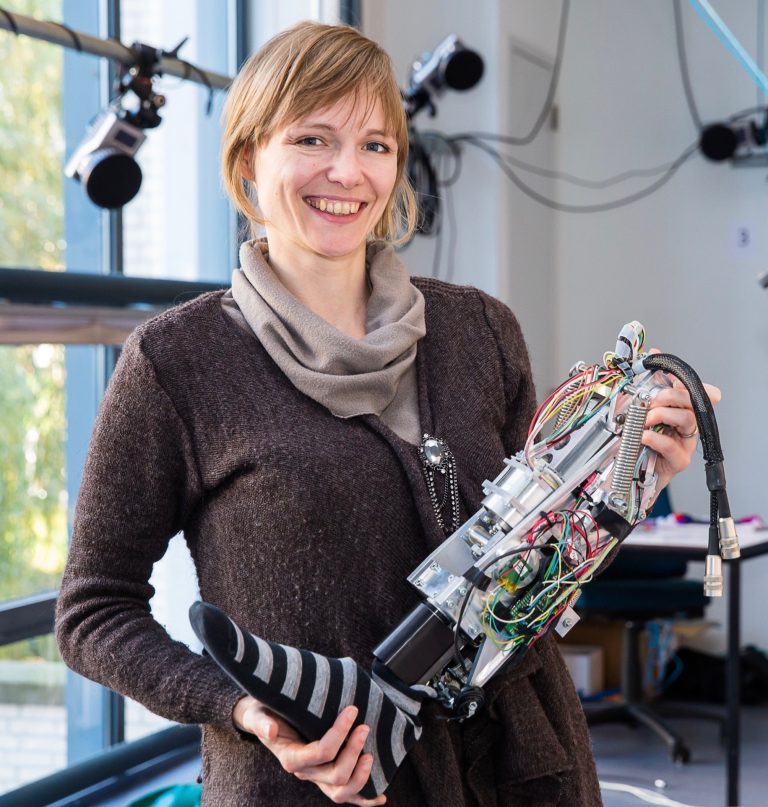As healthcare becomes increasingly complex, Professor Heike Vallery strives for simpler and lighter systems for learning to walk again.
Professor Heike Vallery with the prototype of the balance backpack in the robotics laboratory. (Photo: Sija van den Beukel)
Walking is anything but self-evident. You are constantly fighting gravity, one of the reasons why bipedal, or two-legged, walking is so difficult to imitate. Professor Heike Vallery studies how people walk, how robots walk, and how robotic tools can help people learn to walk again. On Friday, in her inaugural lecture, Vallery will discuss how minimalist and unconventional ideas support human gait and balance.
What makes the human gait so interesting?
“Bipedal walking is a challenging activity that seems to work so effortlessly for most people. But you are constantly going against gravity and the risk of falling over. Yet it works intuitively, you don’t even have to think about it. I find that fascinating, as fascinating as how difficult it is, technically, to mimic.”
How did you end up in this field?
“On an internship in the automobile industry in South America, it struck me that there were very few wheelchair users on the streets. That also had to do with the infrastructure in the city, after all if the roads are bad for pedestrians, you can’t use wheels for transport. Between the roads and the footpaths there are gutter you had to jump over. That’s where I got the naive idea of building a robot suit. Eventually, I ended up with a research group that was already doing something similar at the TU München. From there, I’ve been involved in a growing field.”
Why do you call the idea of a robot suit naive?
“The idea is not naive, but I was naive back then. These days, I don’t think that robot suits will be widespread, at least not in their current form. The robot suit does have its own niche market, but to be honest I don’t think we will see many people on the streets in robot suits. I think expectations are far too high and we are not going to fulfil them.”
Why do you think robot suits won’t be widespread?
“Mainly because of the cost, weight and usability. Furthermore, robot suits are not yet safe enough. You often have to use your hands or crutches to balance. You also need an attendant. Sustainability is an important factor as well. There is already a shortage of resources because of the number of smartphones in the world. And a smartphone is nothing compared to a robot suit.”
What then should be the focus of the research?
“Our research group wants to work on simple solutions that are accessible to a wider audience. Healthcare is becoming increasingly smarter and more complex and this needs a countermovement. Our research into complex robots generates a lot of knowledge that we can apply to simpler systems. That’s where we have to start picking the low-hanging fruit – the simple solutions that are waiting to be picked up.”
Can you give an example of a simple solution for a wider audience?
“One example is the WOLK start-up. We have done a lot of research on how human balance works and how you can recognise if someone is not in balance. The algorithms we created for this purpose were used by WOLK for their hip airbags. These airbags prevent hip bone fractures in the event of a fall. They are now for sale for a few hundred euros.
Another example is our work on knee-prostheses. I used to build a fairly complex knee-prosthesis that mimicked the human leg as closely as possible. This knee replacement turned out to be reasonably usable for active young people but was too heavy for older people. With fellow researcher Gerwin Smit we started to develop lighter knee-prostheses that help people get up. We stored the energy generated by the motion of sitting down in a spring and released it when the person got up. It didn’t need a motor or battery. This saves two-thirds of the weight while still being very helpful.”
What obstacles still stand in the way of minimalist designs?
“Mainly the mindset. When engineers search for solutions, they automatically look at motors and sensors, but there is no need to limit ourselves in the design process. Making a design less complex also makes it less sexy and therefore harder to get funding.”
In November you were appointed Honorary Professor for Innovative Rehabilitation Technology by the Erasmus MC. How does this affect your research?
“I want to work with clinicians even more and look at clinical questions that emerge from practice. I did that before, but now I feel even more part of the clinic. This changes my perspective on the problems and what I can do.”
- Prof. H. Vallery, Inauguration speech Biomechatronics (3mE), 21 February 2020, 15:00, Aula TU Delft.


CV
Heike Vallery (1979) graduated in 2004 in mechanical engineering at the RWTH Aachen. Since then she has worked on robotic tools for rehabilitation and leg prostheses with clinicians and experts in neuroscience and biomechanics. She obtained her PhD in robotics from the Munich University of Technology and continued her research at the ETH Zurich. She worked for one year as an assistant professor at Khalifa University in Abu Dhabi, and from 2012 she joined TU Delft in the same position. She was appointed Professor of Human Motor Augmentation at TU Delft in November 2017. In November 2019 she was appointed Honorary Professor for Innovative Rehabilitation Technology at Erasmus MC Rotterdam. Besides all these activities she plays the trombone in a dance orchestra.
Sija van den Beukel / Freelance journalist



Comments are closed.